Business Process Management: Improving Business Processes Ideas
VerifiedAdded on 2023/03/23
|9
|3022
|93
Essay
AI Summary
This essay discusses the critical role of Business Process Management (BPM) in enhancing organizational efficiency and effectiveness. It focuses on the "Ideas on Improving Business Processes" article, which evaluates the Rethinking of Processes (RePro) method, a technique for generating process improvement ideas. The essay details the research method used to assess RePro's performance, involving graduate scholars in Industrial Engineering and a cataract surgery case study. Findings indicate that the RePro method, particularly when applied with an opportunity-based approach, significantly boosts productivity. The essay also compares the discussed article with other relevant articles, highlighting the importance of timely process inspection, data-driven performance analysis, and consistency between process models and textual descriptions. The conclusion emphasizes that understanding and effectively applying BPM techniques, such as RePro, enables organizational leaders to improve processes and increase overall productivity.
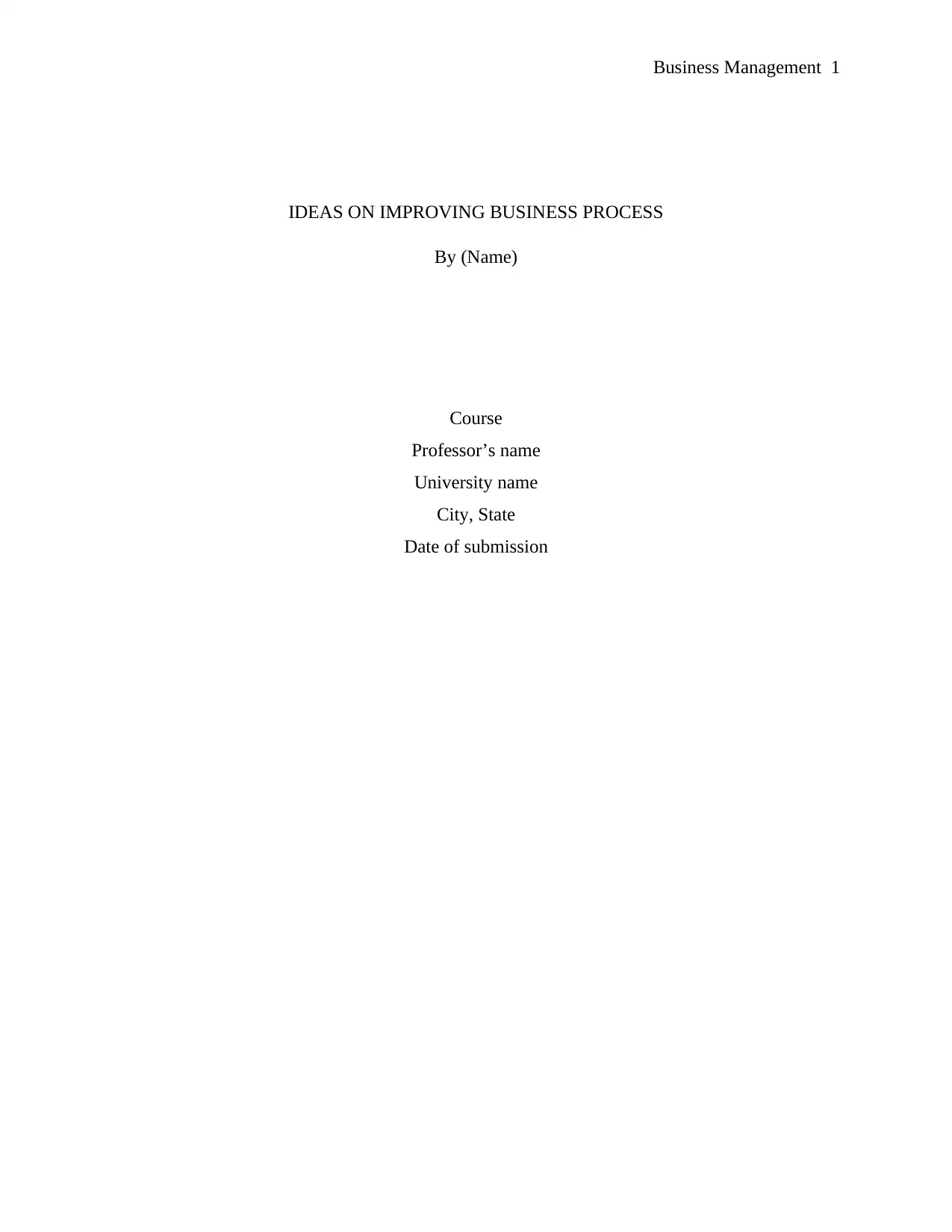
Business Management 1
IDEAS ON IMPROVING BUSINESS PROCESS
By (Name)
Course
Professor’s name
University name
City, State
Date of submission
IDEAS ON IMPROVING BUSINESS PROCESS
By (Name)
Course
Professor’s name
University name
City, State
Date of submission
Paraphrase This Document
Need a fresh take? Get an instant paraphrase of this document with our AI Paraphraser
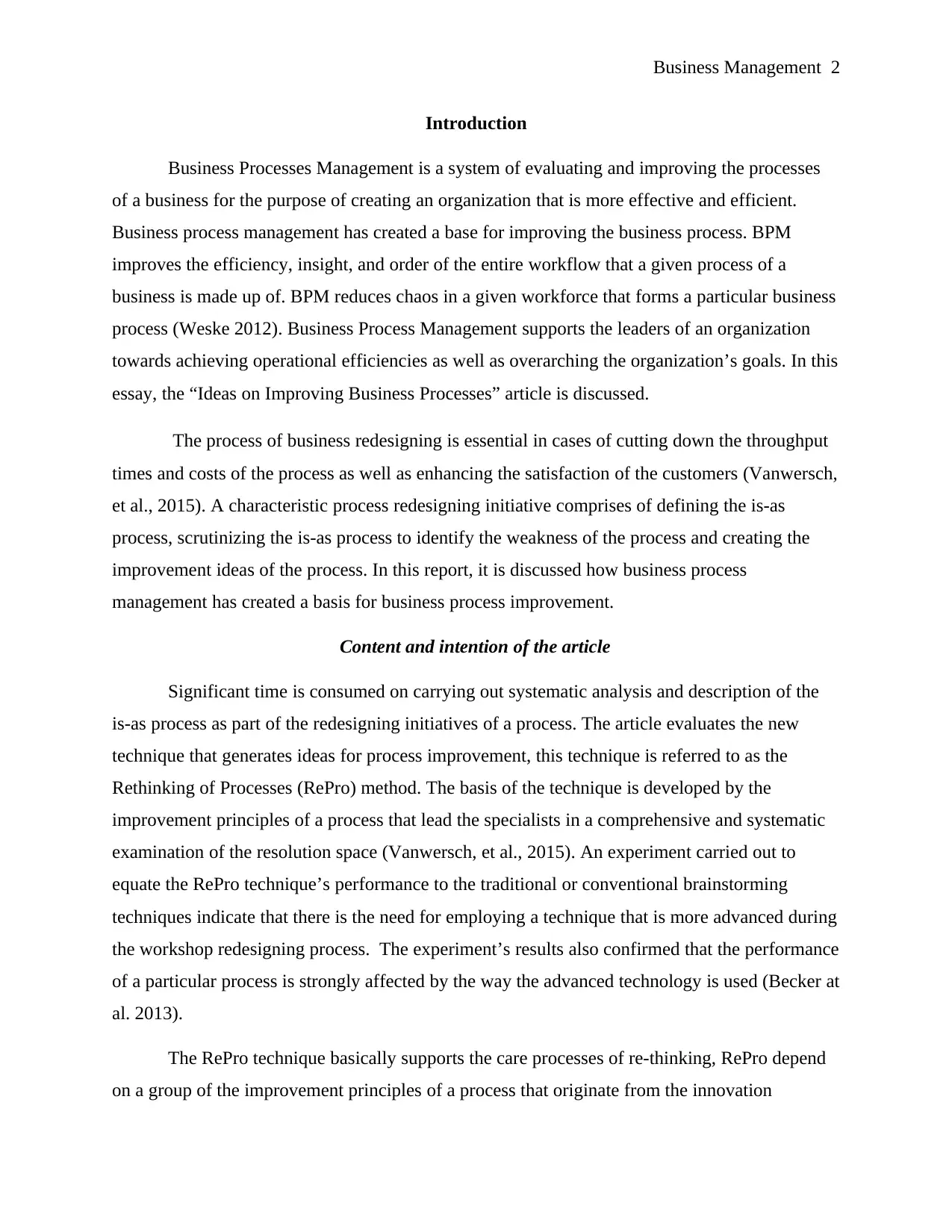
Business Management 2
Introduction
Business Processes Management is a system of evaluating and improving the processes
of a business for the purpose of creating an organization that is more effective and efficient.
Business process management has created a base for improving the business process. BPM
improves the efficiency, insight, and order of the entire workflow that a given process of a
business is made up of. BPM reduces chaos in a given workforce that forms a particular business
process (Weske 2012). Business Process Management supports the leaders of an organization
towards achieving operational efficiencies as well as overarching the organization’s goals. In this
essay, the “Ideas on Improving Business Processes” article is discussed.
The process of business redesigning is essential in cases of cutting down the throughput
times and costs of the process as well as enhancing the satisfaction of the customers (Vanwersch,
et al., 2015). A characteristic process redesigning initiative comprises of defining the is-as
process, scrutinizing the is-as process to identify the weakness of the process and creating the
improvement ideas of the process. In this report, it is discussed how business process
management has created a basis for business process improvement.
Content and intention of the article
Significant time is consumed on carrying out systematic analysis and description of the
is-as process as part of the redesigning initiatives of a process. The article evaluates the new
technique that generates ideas for process improvement, this technique is referred to as the
Rethinking of Processes (RePro) method. The basis of the technique is developed by the
improvement principles of a process that lead the specialists in a comprehensive and systematic
examination of the resolution space (Vanwersch, et al., 2015). An experiment carried out to
equate the RePro technique’s performance to the traditional or conventional brainstorming
techniques indicate that there is the need for employing a technique that is more advanced during
the workshop redesigning process. The experiment’s results also confirmed that the performance
of a particular process is strongly affected by the way the advanced technology is used (Becker at
al. 2013).
The RePro technique basically supports the care processes of re-thinking, RePro depend
on a group of the improvement principles of a process that originate from the innovation
Introduction
Business Processes Management is a system of evaluating and improving the processes
of a business for the purpose of creating an organization that is more effective and efficient.
Business process management has created a base for improving the business process. BPM
improves the efficiency, insight, and order of the entire workflow that a given process of a
business is made up of. BPM reduces chaos in a given workforce that forms a particular business
process (Weske 2012). Business Process Management supports the leaders of an organization
towards achieving operational efficiencies as well as overarching the organization’s goals. In this
essay, the “Ideas on Improving Business Processes” article is discussed.
The process of business redesigning is essential in cases of cutting down the throughput
times and costs of the process as well as enhancing the satisfaction of the customers (Vanwersch,
et al., 2015). A characteristic process redesigning initiative comprises of defining the is-as
process, scrutinizing the is-as process to identify the weakness of the process and creating the
improvement ideas of the process. In this report, it is discussed how business process
management has created a basis for business process improvement.
Content and intention of the article
Significant time is consumed on carrying out systematic analysis and description of the
is-as process as part of the redesigning initiatives of a process. The article evaluates the new
technique that generates ideas for process improvement, this technique is referred to as the
Rethinking of Processes (RePro) method. The basis of the technique is developed by the
improvement principles of a process that lead the specialists in a comprehensive and systematic
examination of the resolution space (Vanwersch, et al., 2015). An experiment carried out to
equate the RePro technique’s performance to the traditional or conventional brainstorming
techniques indicate that there is the need for employing a technique that is more advanced during
the workshop redesigning process. The experiment’s results also confirmed that the performance
of a particular process is strongly affected by the way the advanced technology is used (Becker at
al. 2013).
The RePro technique basically supports the care processes of re-thinking, RePro depend
on a group of the improvement principles of a process that originate from the innovation
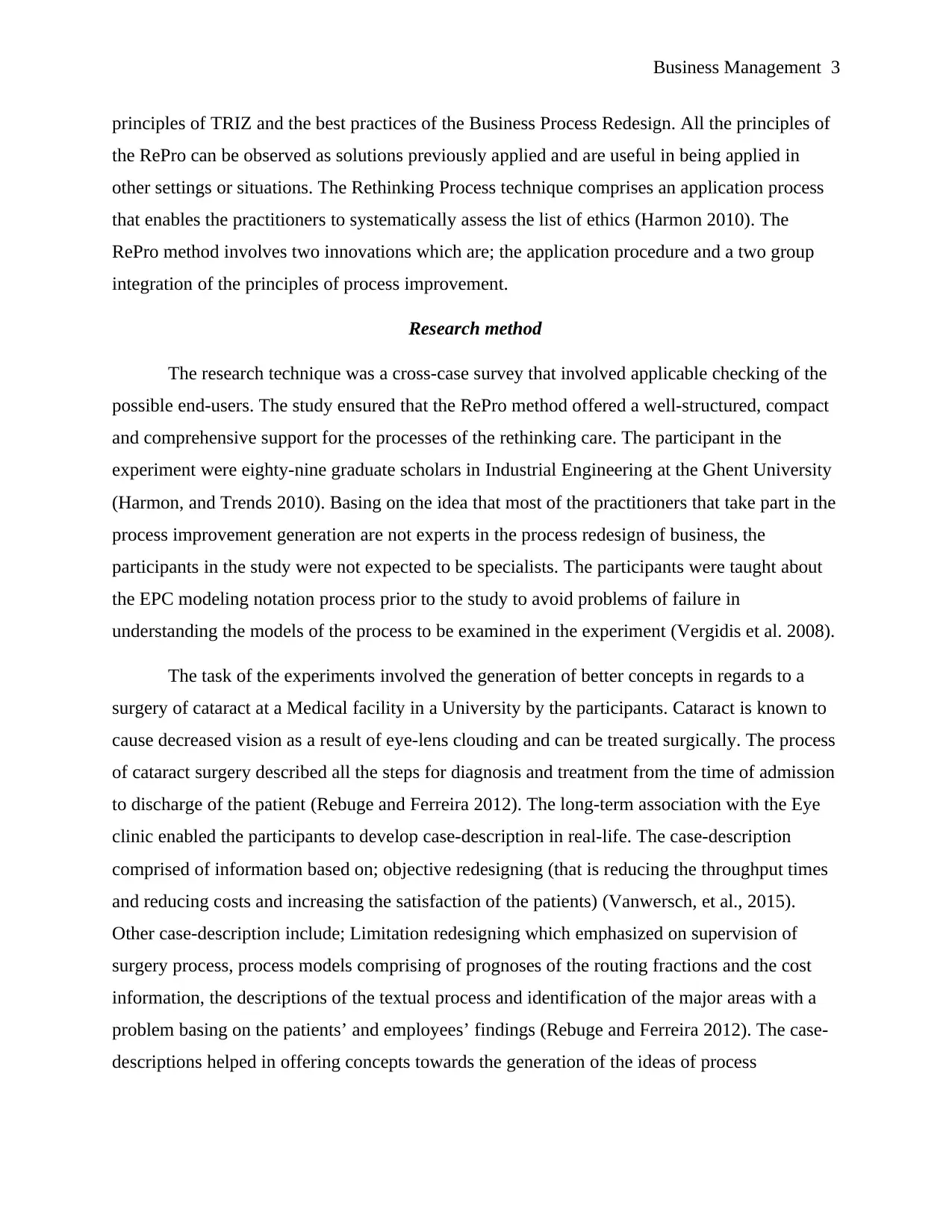
Business Management 3
principles of TRIZ and the best practices of the Business Process Redesign. All the principles of
the RePro can be observed as solutions previously applied and are useful in being applied in
other settings or situations. The Rethinking Process technique comprises an application process
that enables the practitioners to systematically assess the list of ethics (Harmon 2010). The
RePro method involves two innovations which are; the application procedure and a two group
integration of the principles of process improvement.
Research method
The research technique was a cross-case survey that involved applicable checking of the
possible end-users. The study ensured that the RePro method offered a well-structured, compact
and comprehensive support for the processes of the rethinking care. The participant in the
experiment were eighty-nine graduate scholars in Industrial Engineering at the Ghent University
(Harmon, and Trends 2010). Basing on the idea that most of the practitioners that take part in the
process improvement generation are not experts in the process redesign of business, the
participants in the study were not expected to be specialists. The participants were taught about
the EPC modeling notation process prior to the study to avoid problems of failure in
understanding the models of the process to be examined in the experiment (Vergidis et al. 2008).
The task of the experiments involved the generation of better concepts in regards to a
surgery of cataract at a Medical facility in a University by the participants. Cataract is known to
cause decreased vision as a result of eye-lens clouding and can be treated surgically. The process
of cataract surgery described all the steps for diagnosis and treatment from the time of admission
to discharge of the patient (Rebuge and Ferreira 2012). The long-term association with the Eye
clinic enabled the participants to develop case-description in real-life. The case-description
comprised of information based on; objective redesigning (that is reducing the throughput times
and reducing costs and increasing the satisfaction of the patients) (Vanwersch, et al., 2015).
Other case-description include; Limitation redesigning which emphasized on supervision of
surgery process, process models comprising of prognoses of the routing fractions and the cost
information, the descriptions of the textual process and identification of the major areas with a
problem basing on the patients’ and employees’ findings (Rebuge and Ferreira 2012). The case-
descriptions helped in offering concepts towards the generation of the ideas of process
principles of TRIZ and the best practices of the Business Process Redesign. All the principles of
the RePro can be observed as solutions previously applied and are useful in being applied in
other settings or situations. The Rethinking Process technique comprises an application process
that enables the practitioners to systematically assess the list of ethics (Harmon 2010). The
RePro method involves two innovations which are; the application procedure and a two group
integration of the principles of process improvement.
Research method
The research technique was a cross-case survey that involved applicable checking of the
possible end-users. The study ensured that the RePro method offered a well-structured, compact
and comprehensive support for the processes of the rethinking care. The participant in the
experiment were eighty-nine graduate scholars in Industrial Engineering at the Ghent University
(Harmon, and Trends 2010). Basing on the idea that most of the practitioners that take part in the
process improvement generation are not experts in the process redesign of business, the
participants in the study were not expected to be specialists. The participants were taught about
the EPC modeling notation process prior to the study to avoid problems of failure in
understanding the models of the process to be examined in the experiment (Vergidis et al. 2008).
The task of the experiments involved the generation of better concepts in regards to a
surgery of cataract at a Medical facility in a University by the participants. Cataract is known to
cause decreased vision as a result of eye-lens clouding and can be treated surgically. The process
of cataract surgery described all the steps for diagnosis and treatment from the time of admission
to discharge of the patient (Rebuge and Ferreira 2012). The long-term association with the Eye
clinic enabled the participants to develop case-description in real-life. The case-description
comprised of information based on; objective redesigning (that is reducing the throughput times
and reducing costs and increasing the satisfaction of the patients) (Vanwersch, et al., 2015).
Other case-description include; Limitation redesigning which emphasized on supervision of
surgery process, process models comprising of prognoses of the routing fractions and the cost
information, the descriptions of the textual process and identification of the major areas with a
problem basing on the patients’ and employees’ findings (Rebuge and Ferreira 2012). The case-
descriptions helped in offering concepts towards the generation of the ideas of process
⊘ This is a preview!⊘
Do you want full access?
Subscribe today to unlock all pages.

Trusted by 1+ million students worldwide
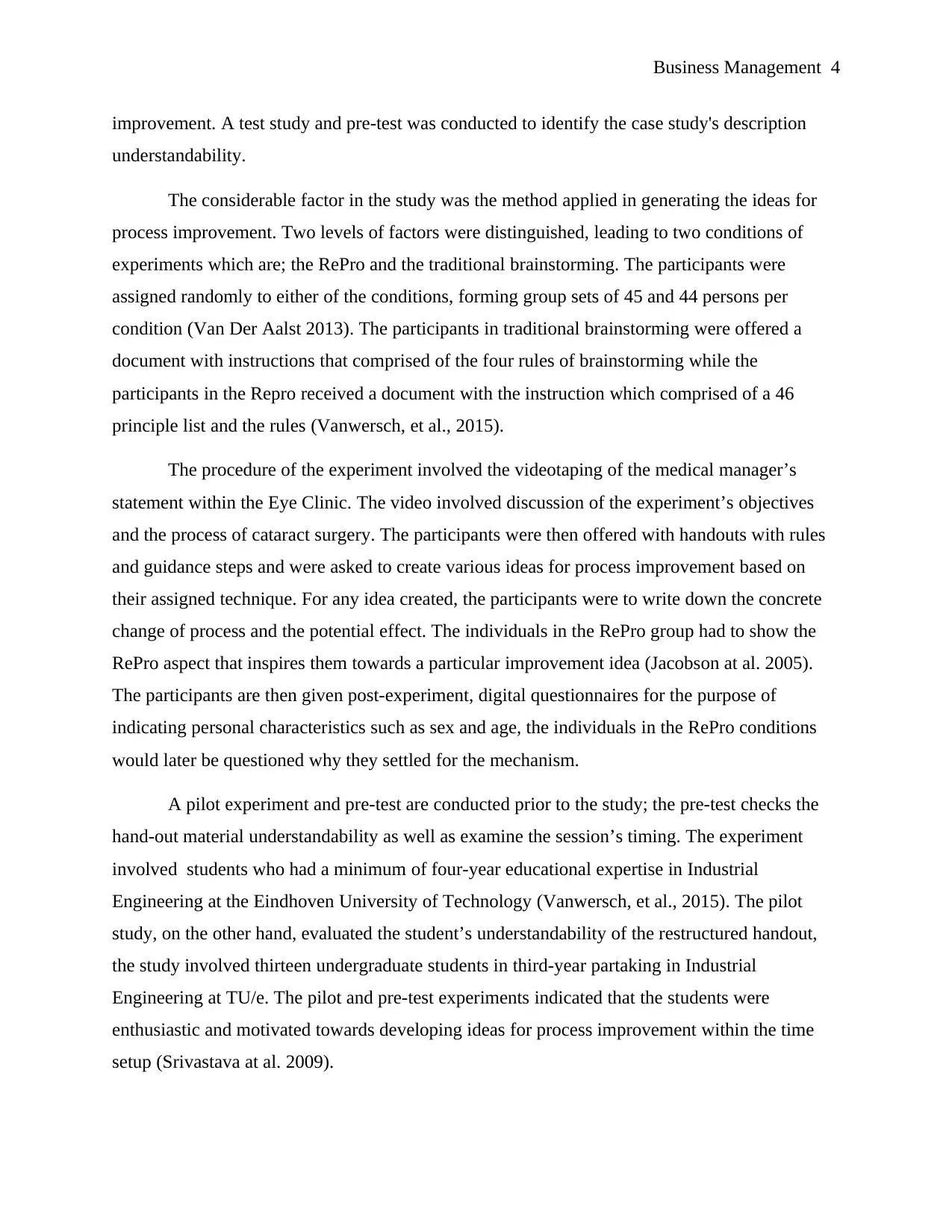
Business Management 4
improvement. A test study and pre-test was conducted to identify the case study's description
understandability.
The considerable factor in the study was the method applied in generating the ideas for
process improvement. Two levels of factors were distinguished, leading to two conditions of
experiments which are; the RePro and the traditional brainstorming. The participants were
assigned randomly to either of the conditions, forming group sets of 45 and 44 persons per
condition (Van Der Aalst 2013). The participants in traditional brainstorming were offered a
document with instructions that comprised of the four rules of brainstorming while the
participants in the Repro received a document with the instruction which comprised of a 46
principle list and the rules (Vanwersch, et al., 2015).
The procedure of the experiment involved the videotaping of the medical manager’s
statement within the Eye Clinic. The video involved discussion of the experiment’s objectives
and the process of cataract surgery. The participants were then offered with handouts with rules
and guidance steps and were asked to create various ideas for process improvement based on
their assigned technique. For any idea created, the participants were to write down the concrete
change of process and the potential effect. The individuals in the RePro group had to show the
RePro aspect that inspires them towards a particular improvement idea (Jacobson at al. 2005).
The participants are then given post-experiment, digital questionnaires for the purpose of
indicating personal characteristics such as sex and age, the individuals in the RePro conditions
would later be questioned why they settled for the mechanism.
A pilot experiment and pre-test are conducted prior to the study; the pre-test checks the
hand-out material understandability as well as examine the session’s timing. The experiment
involved students who had a minimum of four-year educational expertise in Industrial
Engineering at the Eindhoven University of Technology (Vanwersch, et al., 2015). The pilot
study, on the other hand, evaluated the student’s understandability of the restructured handout,
the study involved thirteen undergraduate students in third-year partaking in Industrial
Engineering at TU/e. The pilot and pre-test experiments indicated that the students were
enthusiastic and motivated towards developing ideas for process improvement within the time
setup (Srivastava at al. 2009).
improvement. A test study and pre-test was conducted to identify the case study's description
understandability.
The considerable factor in the study was the method applied in generating the ideas for
process improvement. Two levels of factors were distinguished, leading to two conditions of
experiments which are; the RePro and the traditional brainstorming. The participants were
assigned randomly to either of the conditions, forming group sets of 45 and 44 persons per
condition (Van Der Aalst 2013). The participants in traditional brainstorming were offered a
document with instructions that comprised of the four rules of brainstorming while the
participants in the Repro received a document with the instruction which comprised of a 46
principle list and the rules (Vanwersch, et al., 2015).
The procedure of the experiment involved the videotaping of the medical manager’s
statement within the Eye Clinic. The video involved discussion of the experiment’s objectives
and the process of cataract surgery. The participants were then offered with handouts with rules
and guidance steps and were asked to create various ideas for process improvement based on
their assigned technique. For any idea created, the participants were to write down the concrete
change of process and the potential effect. The individuals in the RePro group had to show the
RePro aspect that inspires them towards a particular improvement idea (Jacobson at al. 2005).
The participants are then given post-experiment, digital questionnaires for the purpose of
indicating personal characteristics such as sex and age, the individuals in the RePro conditions
would later be questioned why they settled for the mechanism.
A pilot experiment and pre-test are conducted prior to the study; the pre-test checks the
hand-out material understandability as well as examine the session’s timing. The experiment
involved students who had a minimum of four-year educational expertise in Industrial
Engineering at the Eindhoven University of Technology (Vanwersch, et al., 2015). The pilot
study, on the other hand, evaluated the student’s understandability of the restructured handout,
the study involved thirteen undergraduate students in third-year partaking in Industrial
Engineering at TU/e. The pilot and pre-test experiments indicated that the students were
enthusiastic and motivated towards developing ideas for process improvement within the time
setup (Srivastava at al. 2009).
Paraphrase This Document
Need a fresh take? Get an instant paraphrase of this document with our AI Paraphraser
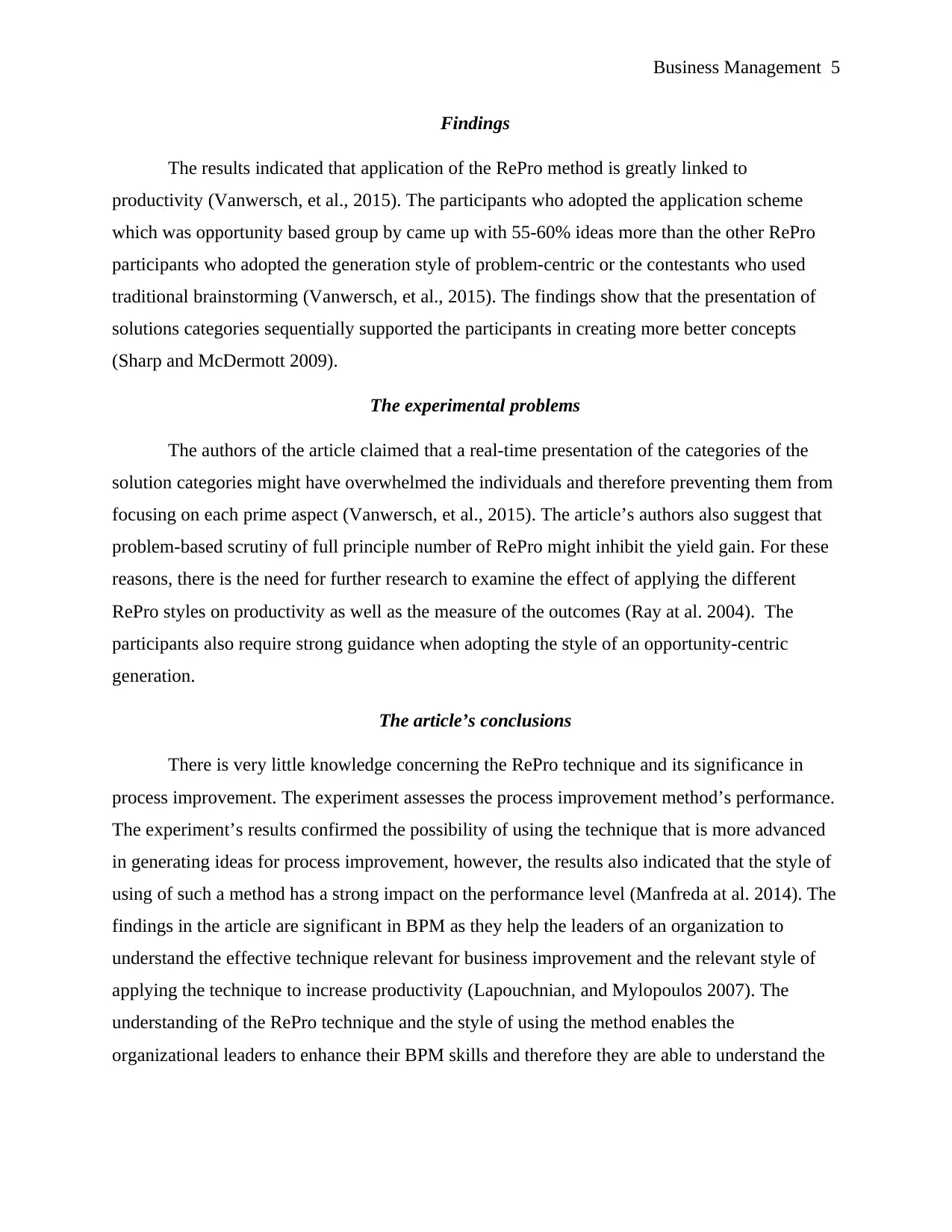
Business Management 5
Findings
The results indicated that application of the RePro method is greatly linked to
productivity (Vanwersch, et al., 2015). The participants who adopted the application scheme
which was opportunity based group by came up with 55-60% ideas more than the other RePro
participants who adopted the generation style of problem-centric or the contestants who used
traditional brainstorming (Vanwersch, et al., 2015). The findings show that the presentation of
solutions categories sequentially supported the participants in creating more better concepts
(Sharp and McDermott 2009).
The experimental problems
The authors of the article claimed that a real-time presentation of the categories of the
solution categories might have overwhelmed the individuals and therefore preventing them from
focusing on each prime aspect (Vanwersch, et al., 2015). The article’s authors also suggest that
problem-based scrutiny of full principle number of RePro might inhibit the yield gain. For these
reasons, there is the need for further research to examine the effect of applying the different
RePro styles on productivity as well as the measure of the outcomes (Ray at al. 2004). The
participants also require strong guidance when adopting the style of an opportunity-centric
generation.
The article’s conclusions
There is very little knowledge concerning the RePro technique and its significance in
process improvement. The experiment assesses the process improvement method’s performance.
The experiment’s results confirmed the possibility of using the technique that is more advanced
in generating ideas for process improvement, however, the results also indicated that the style of
using of such a method has a strong impact on the performance level (Manfreda at al. 2014). The
findings in the article are significant in BPM as they help the leaders of an organization to
understand the effective technique relevant for business improvement and the relevant style of
applying the technique to increase productivity (Lapouchnian, and Mylopoulos 2007). The
understanding of the RePro technique and the style of using the method enables the
organizational leaders to enhance their BPM skills and therefore they are able to understand the
Findings
The results indicated that application of the RePro method is greatly linked to
productivity (Vanwersch, et al., 2015). The participants who adopted the application scheme
which was opportunity based group by came up with 55-60% ideas more than the other RePro
participants who adopted the generation style of problem-centric or the contestants who used
traditional brainstorming (Vanwersch, et al., 2015). The findings show that the presentation of
solutions categories sequentially supported the participants in creating more better concepts
(Sharp and McDermott 2009).
The experimental problems
The authors of the article claimed that a real-time presentation of the categories of the
solution categories might have overwhelmed the individuals and therefore preventing them from
focusing on each prime aspect (Vanwersch, et al., 2015). The article’s authors also suggest that
problem-based scrutiny of full principle number of RePro might inhibit the yield gain. For these
reasons, there is the need for further research to examine the effect of applying the different
RePro styles on productivity as well as the measure of the outcomes (Ray at al. 2004). The
participants also require strong guidance when adopting the style of an opportunity-centric
generation.
The article’s conclusions
There is very little knowledge concerning the RePro technique and its significance in
process improvement. The experiment assesses the process improvement method’s performance.
The experiment’s results confirmed the possibility of using the technique that is more advanced
in generating ideas for process improvement, however, the results also indicated that the style of
using of such a method has a strong impact on the performance level (Manfreda at al. 2014). The
findings in the article are significant in BPM as they help the leaders of an organization to
understand the effective technique relevant for business improvement and the relevant style of
applying the technique to increase productivity (Lapouchnian, and Mylopoulos 2007). The
understanding of the RePro technique and the style of using the method enables the
organizational leaders to enhance their BPM skills and therefore they are able to understand the
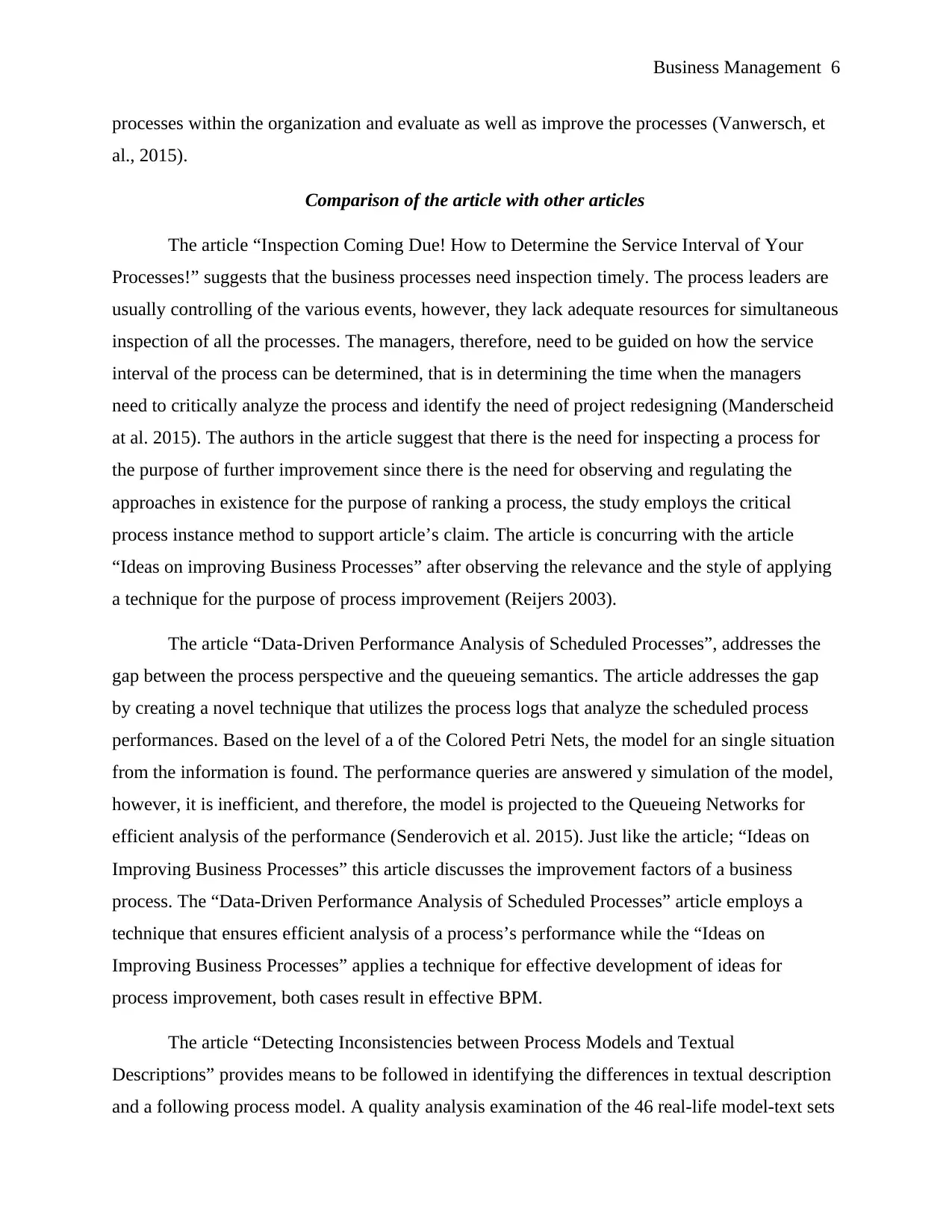
Business Management 6
processes within the organization and evaluate as well as improve the processes (Vanwersch, et
al., 2015).
Comparison of the article with other articles
The article “Inspection Coming Due! How to Determine the Service Interval of Your
Processes!” suggests that the business processes need inspection timely. The process leaders are
usually controlling of the various events, however, they lack adequate resources for simultaneous
inspection of all the processes. The managers, therefore, need to be guided on how the service
interval of the process can be determined, that is in determining the time when the managers
need to critically analyze the process and identify the need of project redesigning (Manderscheid
at al. 2015). The authors in the article suggest that there is the need for inspecting a process for
the purpose of further improvement since there is the need for observing and regulating the
approaches in existence for the purpose of ranking a process, the study employs the critical
process instance method to support article’s claim. The article is concurring with the article
“Ideas on improving Business Processes” after observing the relevance and the style of applying
a technique for the purpose of process improvement (Reijers 2003).
The article “Data-Driven Performance Analysis of Scheduled Processes”, addresses the
gap between the process perspective and the queueing semantics. The article addresses the gap
by creating a novel technique that utilizes the process logs that analyze the scheduled process
performances. Based on the level of a of the Colored Petri Nets, the model for an single situation
from the information is found. The performance queries are answered y simulation of the model,
however, it is inefficient, and therefore, the model is projected to the Queueing Networks for
efficient analysis of the performance (Senderovich et al. 2015). Just like the article; “Ideas on
Improving Business Processes” this article discusses the improvement factors of a business
process. The “Data-Driven Performance Analysis of Scheduled Processes” article employs a
technique that ensures efficient analysis of a process’s performance while the “Ideas on
Improving Business Processes” applies a technique for effective development of ideas for
process improvement, both cases result in effective BPM.
The article “Detecting Inconsistencies between Process Models and Textual
Descriptions” provides means to be followed in identifying the differences in textual description
and a following process model. A quality analysis examination of the 46 real-life model-text sets
processes within the organization and evaluate as well as improve the processes (Vanwersch, et
al., 2015).
Comparison of the article with other articles
The article “Inspection Coming Due! How to Determine the Service Interval of Your
Processes!” suggests that the business processes need inspection timely. The process leaders are
usually controlling of the various events, however, they lack adequate resources for simultaneous
inspection of all the processes. The managers, therefore, need to be guided on how the service
interval of the process can be determined, that is in determining the time when the managers
need to critically analyze the process and identify the need of project redesigning (Manderscheid
at al. 2015). The authors in the article suggest that there is the need for inspecting a process for
the purpose of further improvement since there is the need for observing and regulating the
approaches in existence for the purpose of ranking a process, the study employs the critical
process instance method to support article’s claim. The article is concurring with the article
“Ideas on improving Business Processes” after observing the relevance and the style of applying
a technique for the purpose of process improvement (Reijers 2003).
The article “Data-Driven Performance Analysis of Scheduled Processes”, addresses the
gap between the process perspective and the queueing semantics. The article addresses the gap
by creating a novel technique that utilizes the process logs that analyze the scheduled process
performances. Based on the level of a of the Colored Petri Nets, the model for an single situation
from the information is found. The performance queries are answered y simulation of the model,
however, it is inefficient, and therefore, the model is projected to the Queueing Networks for
efficient analysis of the performance (Senderovich et al. 2015). Just like the article; “Ideas on
Improving Business Processes” this article discusses the improvement factors of a business
process. The “Data-Driven Performance Analysis of Scheduled Processes” article employs a
technique that ensures efficient analysis of a process’s performance while the “Ideas on
Improving Business Processes” applies a technique for effective development of ideas for
process improvement, both cases result in effective BPM.
The article “Detecting Inconsistencies between Process Models and Textual
Descriptions” provides means to be followed in identifying the differences in textual description
and a following process model. A quality analysis examination of the 46 real-life model-text sets
⊘ This is a preview!⊘
Do you want full access?
Subscribe today to unlock all pages.

Trusted by 1+ million students worldwide
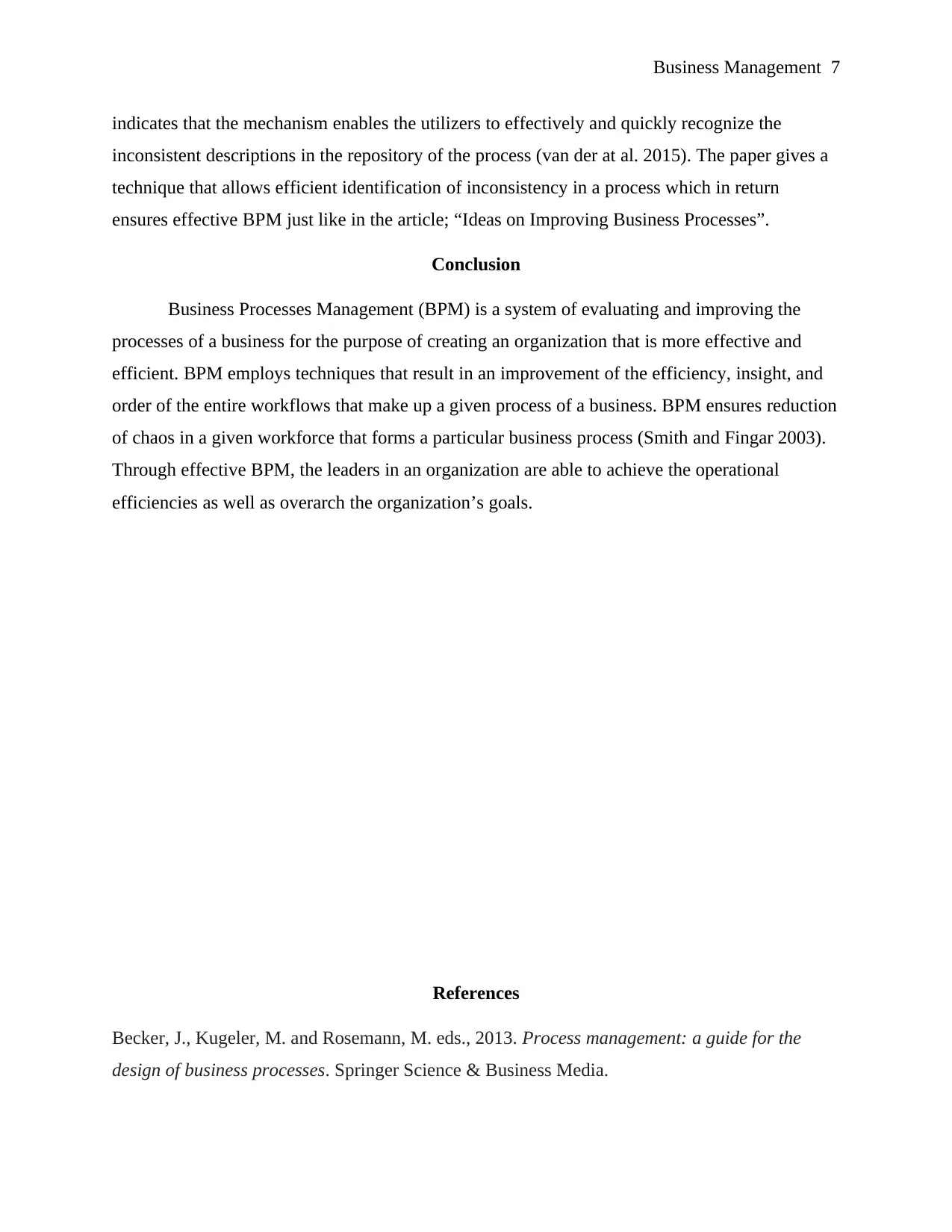
Business Management 7
indicates that the mechanism enables the utilizers to effectively and quickly recognize the
inconsistent descriptions in the repository of the process (van der at al. 2015). The paper gives a
technique that allows efficient identification of inconsistency in a process which in return
ensures effective BPM just like in the article; “Ideas on Improving Business Processes”.
Conclusion
Business Processes Management (BPM) is a system of evaluating and improving the
processes of a business for the purpose of creating an organization that is more effective and
efficient. BPM employs techniques that result in an improvement of the efficiency, insight, and
order of the entire workflows that make up a given process of a business. BPM ensures reduction
of chaos in a given workforce that forms a particular business process (Smith and Fingar 2003).
Through effective BPM, the leaders in an organization are able to achieve the operational
efficiencies as well as overarch the organization’s goals.
References
Becker, J., Kugeler, M. and Rosemann, M. eds., 2013. Process management: a guide for the
design of business processes. Springer Science & Business Media.
indicates that the mechanism enables the utilizers to effectively and quickly recognize the
inconsistent descriptions in the repository of the process (van der at al. 2015). The paper gives a
technique that allows efficient identification of inconsistency in a process which in return
ensures effective BPM just like in the article; “Ideas on Improving Business Processes”.
Conclusion
Business Processes Management (BPM) is a system of evaluating and improving the
processes of a business for the purpose of creating an organization that is more effective and
efficient. BPM employs techniques that result in an improvement of the efficiency, insight, and
order of the entire workflows that make up a given process of a business. BPM ensures reduction
of chaos in a given workforce that forms a particular business process (Smith and Fingar 2003).
Through effective BPM, the leaders in an organization are able to achieve the operational
efficiencies as well as overarch the organization’s goals.
References
Becker, J., Kugeler, M. and Rosemann, M. eds., 2013. Process management: a guide for the
design of business processes. Springer Science & Business Media.
Paraphrase This Document
Need a fresh take? Get an instant paraphrase of this document with our AI Paraphraser
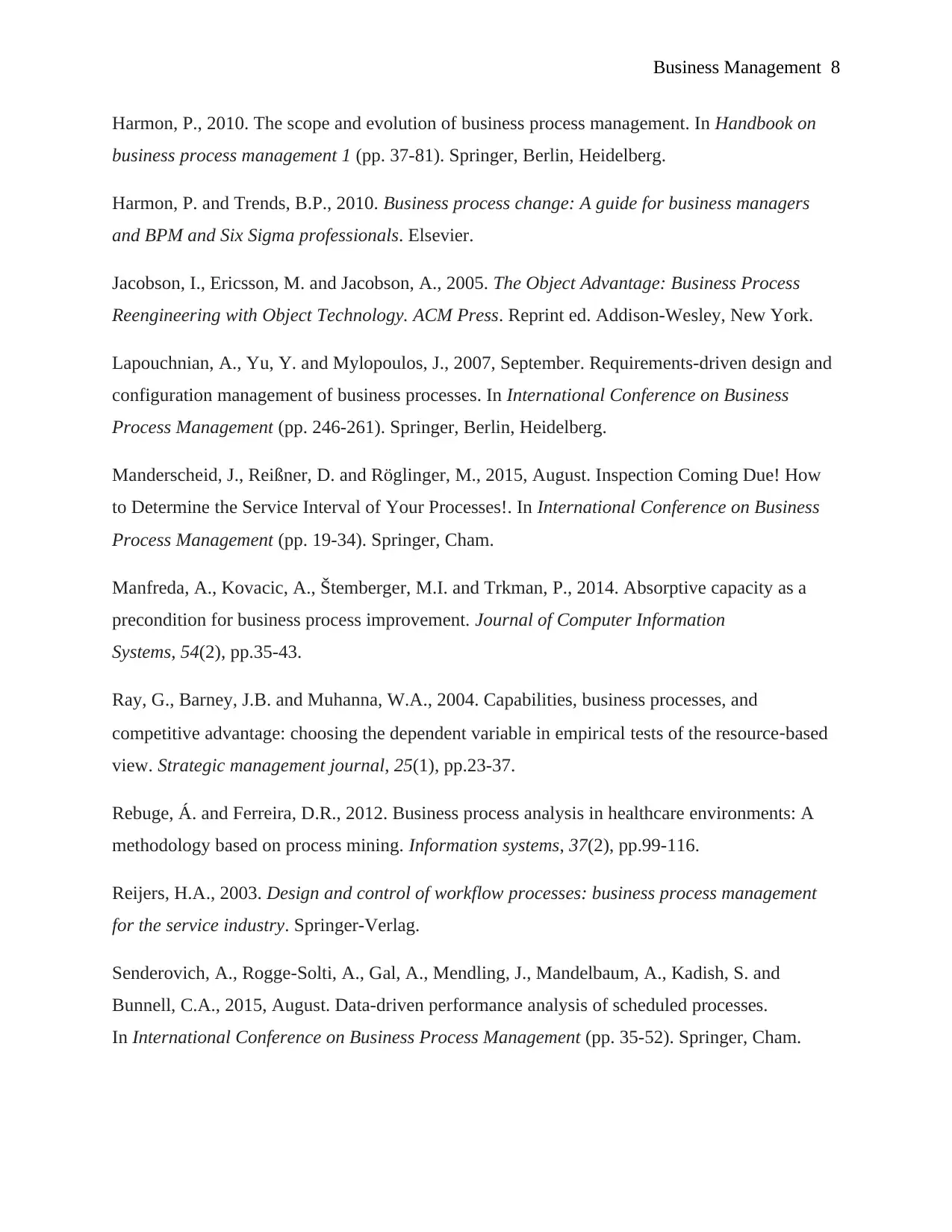
Business Management 8
Harmon, P., 2010. The scope and evolution of business process management. In Handbook on
business process management 1 (pp. 37-81). Springer, Berlin, Heidelberg.
Harmon, P. and Trends, B.P., 2010. Business process change: A guide for business managers
and BPM and Six Sigma professionals. Elsevier.
Jacobson, I., Ericsson, M. and Jacobson, A., 2005. The Object Advantage: Business Process
Reengineering with Object Technology. ACM Press. Reprint ed. Addison-Wesley, New York.
Lapouchnian, A., Yu, Y. and Mylopoulos, J., 2007, September. Requirements-driven design and
configuration management of business processes. In International Conference on Business
Process Management (pp. 246-261). Springer, Berlin, Heidelberg.
Manderscheid, J., Reißner, D. and Röglinger, M., 2015, August. Inspection Coming Due! How
to Determine the Service Interval of Your Processes!. In International Conference on Business
Process Management (pp. 19-34). Springer, Cham.
Manfreda, A., Kovacic, A., Štemberger, M.I. and Trkman, P., 2014. Absorptive capacity as a
precondition for business process improvement. Journal of Computer Information
Systems, 54(2), pp.35-43.
Ray, G., Barney, J.B. and Muhanna, W.A., 2004. Capabilities, business processes, and
competitive advantage: choosing the dependent variable in empirical tests of the resource‐based
view. Strategic management journal, 25(1), pp.23-37.
Rebuge, Á. and Ferreira, D.R., 2012. Business process analysis in healthcare environments: A
methodology based on process mining. Information systems, 37(2), pp.99-116.
Reijers, H.A., 2003. Design and control of workflow processes: business process management
for the service industry. Springer-Verlag.
Senderovich, A., Rogge-Solti, A., Gal, A., Mendling, J., Mandelbaum, A., Kadish, S. and
Bunnell, C.A., 2015, August. Data-driven performance analysis of scheduled processes.
In International Conference on Business Process Management (pp. 35-52). Springer, Cham.
Harmon, P., 2010. The scope and evolution of business process management. In Handbook on
business process management 1 (pp. 37-81). Springer, Berlin, Heidelberg.
Harmon, P. and Trends, B.P., 2010. Business process change: A guide for business managers
and BPM and Six Sigma professionals. Elsevier.
Jacobson, I., Ericsson, M. and Jacobson, A., 2005. The Object Advantage: Business Process
Reengineering with Object Technology. ACM Press. Reprint ed. Addison-Wesley, New York.
Lapouchnian, A., Yu, Y. and Mylopoulos, J., 2007, September. Requirements-driven design and
configuration management of business processes. In International Conference on Business
Process Management (pp. 246-261). Springer, Berlin, Heidelberg.
Manderscheid, J., Reißner, D. and Röglinger, M., 2015, August. Inspection Coming Due! How
to Determine the Service Interval of Your Processes!. In International Conference on Business
Process Management (pp. 19-34). Springer, Cham.
Manfreda, A., Kovacic, A., Štemberger, M.I. and Trkman, P., 2014. Absorptive capacity as a
precondition for business process improvement. Journal of Computer Information
Systems, 54(2), pp.35-43.
Ray, G., Barney, J.B. and Muhanna, W.A., 2004. Capabilities, business processes, and
competitive advantage: choosing the dependent variable in empirical tests of the resource‐based
view. Strategic management journal, 25(1), pp.23-37.
Rebuge, Á. and Ferreira, D.R., 2012. Business process analysis in healthcare environments: A
methodology based on process mining. Information systems, 37(2), pp.99-116.
Reijers, H.A., 2003. Design and control of workflow processes: business process management
for the service industry. Springer-Verlag.
Senderovich, A., Rogge-Solti, A., Gal, A., Mendling, J., Mandelbaum, A., Kadish, S. and
Bunnell, C.A., 2015, August. Data-driven performance analysis of scheduled processes.
In International Conference on Business Process Management (pp. 35-52). Springer, Cham.
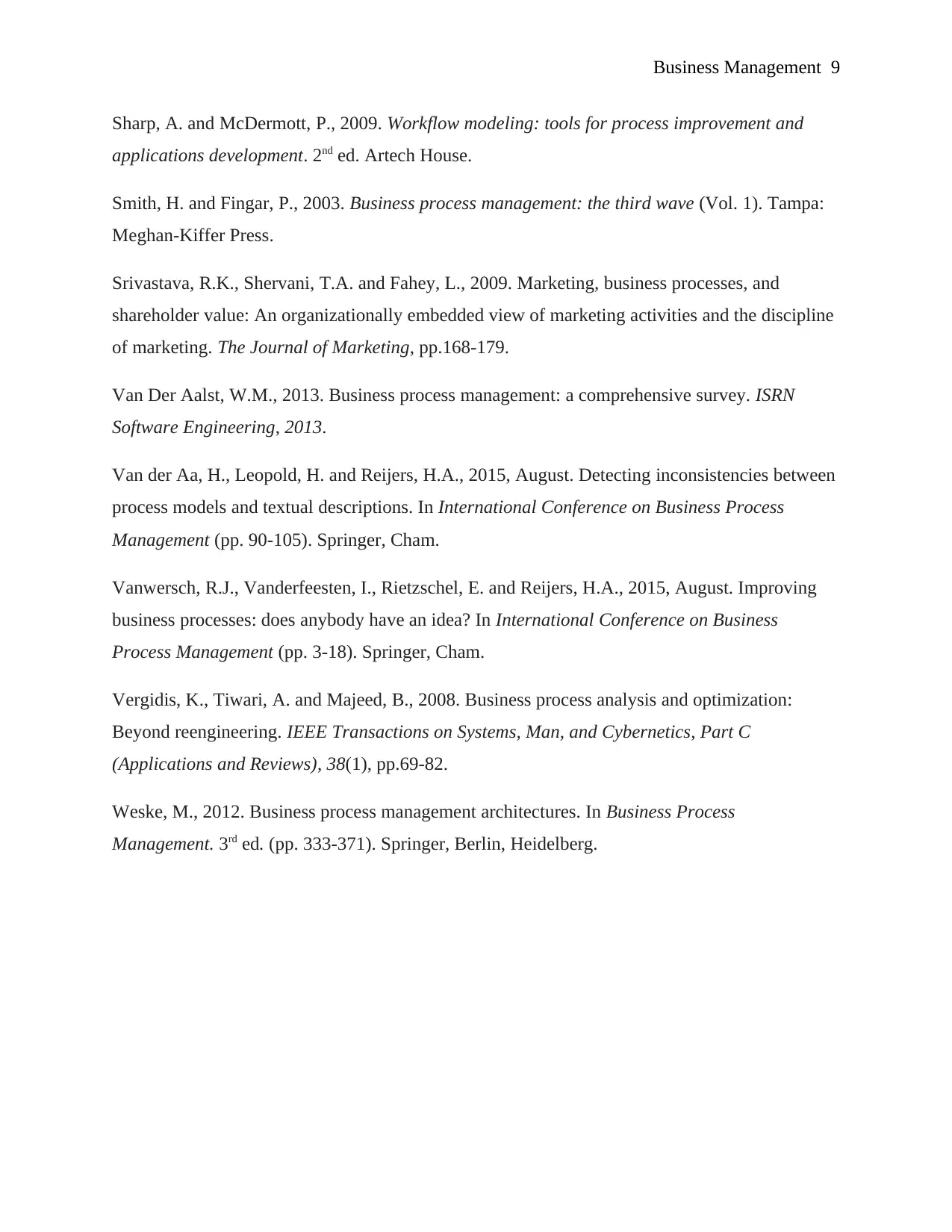
Business Management 9
Sharp, A. and McDermott, P., 2009. Workflow modeling: tools for process improvement and
applications development. 2nd ed. Artech House.
Smith, H. and Fingar, P., 2003. Business process management: the third wave (Vol. 1). Tampa:
Meghan-Kiffer Press.
Srivastava, R.K., Shervani, T.A. and Fahey, L., 2009. Marketing, business processes, and
shareholder value: An organizationally embedded view of marketing activities and the discipline
of marketing. The Journal of Marketing, pp.168-179.
Van Der Aalst, W.M., 2013. Business process management: a comprehensive survey. ISRN
Software Engineering, 2013.
Van der Aa, H., Leopold, H. and Reijers, H.A., 2015, August. Detecting inconsistencies between
process models and textual descriptions. In International Conference on Business Process
Management (pp. 90-105). Springer, Cham.
Vanwersch, R.J., Vanderfeesten, I., Rietzschel, E. and Reijers, H.A., 2015, August. Improving
business processes: does anybody have an idea? In International Conference on Business
Process Management (pp. 3-18). Springer, Cham.
Vergidis, K., Tiwari, A. and Majeed, B., 2008. Business process analysis and optimization:
Beyond reengineering. IEEE Transactions on Systems, Man, and Cybernetics, Part C
(Applications and Reviews), 38(1), pp.69-82.
Weske, M., 2012. Business process management architectures. In Business Process
Management. 3rd ed. (pp. 333-371). Springer, Berlin, Heidelberg.
Sharp, A. and McDermott, P., 2009. Workflow modeling: tools for process improvement and
applications development. 2nd ed. Artech House.
Smith, H. and Fingar, P., 2003. Business process management: the third wave (Vol. 1). Tampa:
Meghan-Kiffer Press.
Srivastava, R.K., Shervani, T.A. and Fahey, L., 2009. Marketing, business processes, and
shareholder value: An organizationally embedded view of marketing activities and the discipline
of marketing. The Journal of Marketing, pp.168-179.
Van Der Aalst, W.M., 2013. Business process management: a comprehensive survey. ISRN
Software Engineering, 2013.
Van der Aa, H., Leopold, H. and Reijers, H.A., 2015, August. Detecting inconsistencies between
process models and textual descriptions. In International Conference on Business Process
Management (pp. 90-105). Springer, Cham.
Vanwersch, R.J., Vanderfeesten, I., Rietzschel, E. and Reijers, H.A., 2015, August. Improving
business processes: does anybody have an idea? In International Conference on Business
Process Management (pp. 3-18). Springer, Cham.
Vergidis, K., Tiwari, A. and Majeed, B., 2008. Business process analysis and optimization:
Beyond reengineering. IEEE Transactions on Systems, Man, and Cybernetics, Part C
(Applications and Reviews), 38(1), pp.69-82.
Weske, M., 2012. Business process management architectures. In Business Process
Management. 3rd ed. (pp. 333-371). Springer, Berlin, Heidelberg.
⊘ This is a preview!⊘
Do you want full access?
Subscribe today to unlock all pages.

Trusted by 1+ million students worldwide
1 out of 9
Related Documents
Your All-in-One AI-Powered Toolkit for Academic Success.
+13062052269
info@desklib.com
Available 24*7 on WhatsApp / Email
![[object Object]](/_next/static/media/star-bottom.7253800d.svg)
Unlock your academic potential
Copyright © 2020–2025 A2Z Services. All Rights Reserved. Developed and managed by ZUCOL.





